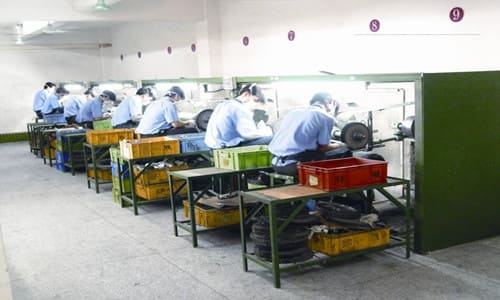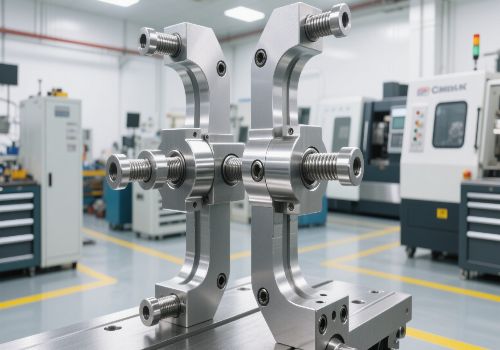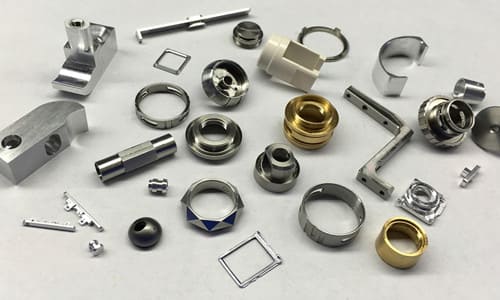Polishing refers to the use of mechanical, chemical or electrochemical effects to reduce the surface roughness of the workpiece to obtain a bright and smooth surface. At present, it is widely used in various industries, such as consumer electronics, home appliances, automobiles, etc.
Polishing is a traditional and necessary manufacturing process, but at the same time, a large amount of dust is generated during the polishing process, which seriously endangers the health of the workshop and workers. Environmental protection issues have attracted much attention.
There are many types of polishing processes, including mechanical polishing, electrolytic polishing, chemical polishing and nano polishing.
Today we look at the comparison of the advantages and disadvantages of these four polishing processes.
1. Mechanical polishing
Mechanical polishing is currently widely used in various manufacturing industries. It is carried out on a dedicated polishing machine, which is mainly composed of a motor and a polishing disc. According to different product materials, polishing consumables of different materials are placed on the polishing disc. The selection of rough polishing and fine polishing consumables is different. When polishing, the sample should be flatly pressed on the rotating polishing disk. The pressure should not be too large, and it should continuously reciprocate radially from the edge to the center of the disk. Through the relative grinding and rolling action between the extremely fine polishing powder (liquid) and the grinding surface, the wear marks are eliminated and a bright mirror surface is obtained.
Advantages and disadvantages of mechanical polishing:
The advantage is low cost and simple operation;
The disadvantage is low efficiency, easy to cause uneven polishing surface, difficult to control polishing time, only suitable for small area surface treatment.
2. Electrolytic polishing
Electrolytic polishing is a kind of anodic polishing. It is a kind of electrolytic machining on the principle that the anode is first dissolved in a specific electrolyte and an appropriate current density. It is also called electropolishing. At present, electrolytic polishing of stainless steel is favored by more and more enterprises and is an environmentally friendly polishing.
Advantages and disadvantages of electrolytic polishing:
The advantage lies in the ability to polish hard and soft materials that are difficult to mechanically polish, as well as thin-walled, complex-shaped, and small parts and products. The polishing time is short, multiple pieces can be polished at the same time, and the production efficiency is high, the cost is low, and the surface of the product is corrosion resistant It will not cause deformation of the metal surface, etc.;
The disadvantage is that the pre-polishing treatment is more complicated, the electrolyte has poor versatility, short service life, strong corrosiveness and difficult handling.
3. Chemical polishing
Chemical polishing is similar to electrolytic polishing. It is a method to eliminate wear marks on the surface of the sample by the chemical etching of chemical reagents. The chemical polishing equipment is simple, capable of processing thin tubes, parts with deep holes and complex shapes, and high production efficiency. Chemical polishing can be used as a pretreatment process for electroplating, and can also be used directly after polishing with the necessary protective measures.
Advantages and disadvantages of chemical polishing:
The advantage is that the chemical polishing equipment is simple and can handle parts with more complex shapes;
The disadvantage is that the polishing quality is not as good as electrolytic polishing. The polishing solution used has a short service life and is difficult to adjust and regenerate. During the chemical polishing operation, nitric acid emits a large amount of yellow-brown harmful gas, which causes serious environmental pollution.
4. Nano polishing
Nano polishing is called plasma polishing, which is a new type of environmentally friendly polishing process. The polishing liquid used in nano polishing has small oxide particle size and strong hardness, so no scratches are generated during polishing, and the polishing effect is good. It is widely used in consumer electronics, furniture, medical, automotive, aerospace and other fields.
Compared with the traditional polishing process, the advantages of nano polishing are:
Nano polishing liquid is very environmentally friendly, its waste liquid can be directly discharged without causing pollution, and it can also be slightly treated and recycled.
Plasma nano polishing adopts special automatic control equipment, which is simple to operate and convenient to maintain.
The processing cost is lower, which is conducive to promotion, and can reduce the number of operators and reduce labor costs.
The automatic control equipment can achieve the electroplating mirror effect within ten seconds to two minutes through the special agent, which greatly improves the production efficiency.
The entire workpiece surface and dead corners can achieve a consistent mirror effect, and can also enhance the chemical properties of the product surface.
As a professional CNC machining manufacturer, DO Machining not only produce metal parts, but plastic and wood parts are also available.
Please visit our CAPABILITIES and what PRODUCTS we did.
CNC machining service is the core business of DO Machining, from protptyes to bulk production, our professional 3/4/5 aixs CNC machining centers, CNC turning equipments, CNC turning-milling equipments, CNC grinding machines etc., are operated by well trained manufacturing engineers to meet the demands from global 1000+ customers in 30+ industries.
CNC Machining can be done starting with blanks produced from standard bar stock or one of DO Machining other manufacturing processes.
Contact us to see how we can provide overall value to your CNC machining needs.











